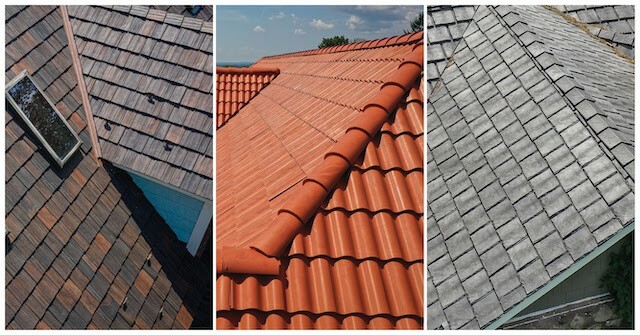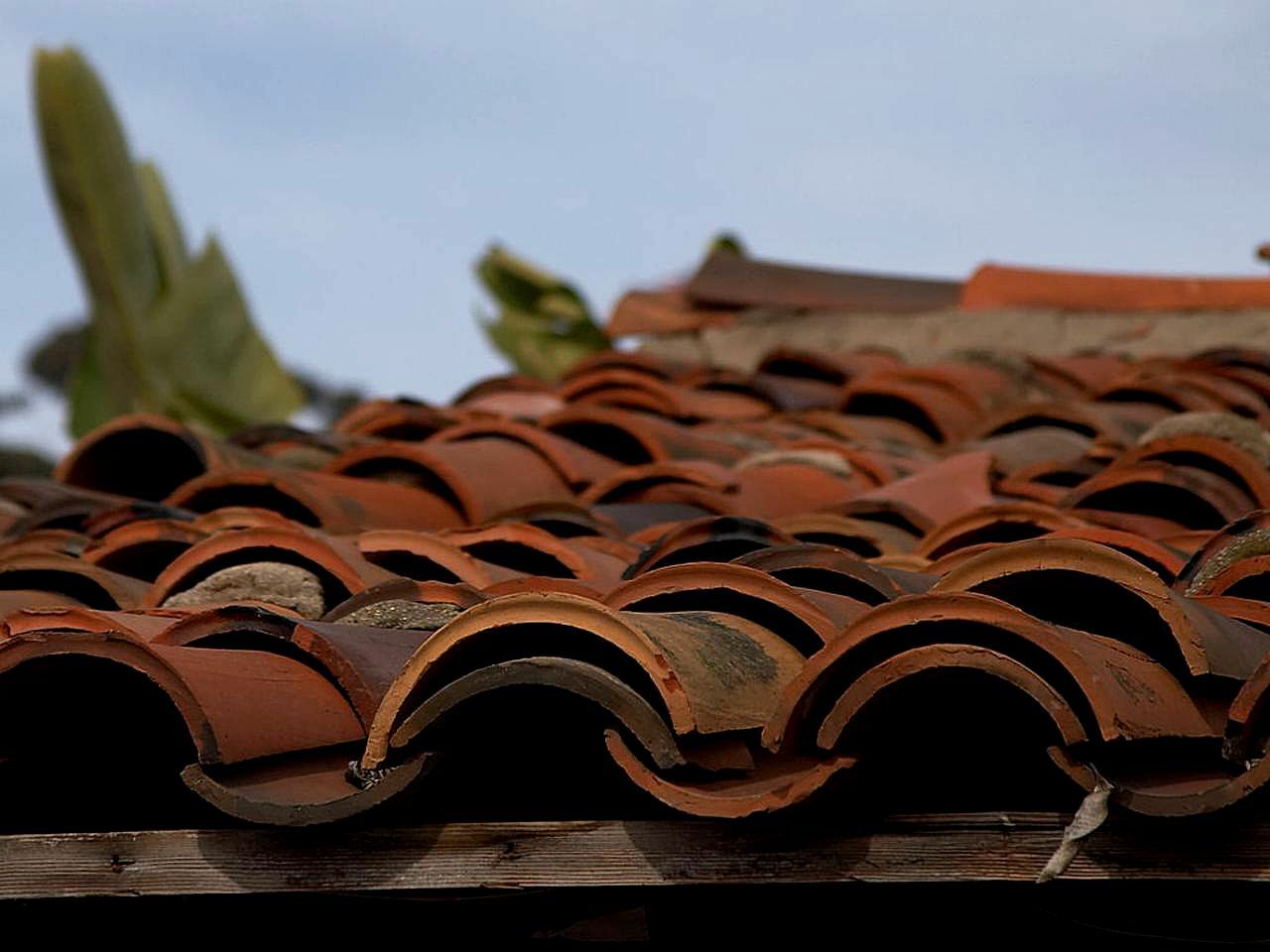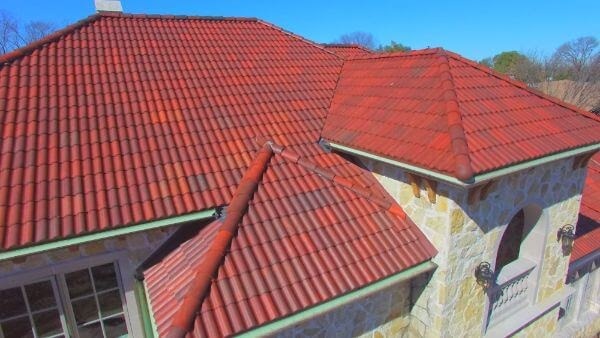A strong, durable, and energy-efficient roof will ensure your family's long-term comfort and safety against heavy rains, snow, flying debris, and the scorching heat of the Sun. It can also save you money through lower energy bills, maintenance, repair, and replacement costs. Furthermore, an aesthetically-pleasing roof will increase the resale value of your house, making it quicker to sell than a home with a dull-unimpressive roof.
Metal vs. Tile Roof
When comparing a metal roof to a tile roof, we found that both have several advantages, but also numerous disadvantages. Specifically, without proper installation and maintenance, impact damage and extreme weather conditions can significantly diminish a metal and tile roof's integrity. Fortunately, Brava synthetic shakes are a more durable, weather-resistant, and low-maintenance roofing material over metal and tile roofing.
How to Select the Right Material for Your Home
With so many roofing products available, how do you decide which is the best one for your home? First, make sure it falls within your budget and contains features compatible with your local climate (rain, snow, wind, ice, etc.) — specifically consider the roofing product's durability, energy-efficiency, aesthetics, and eco-friendliness.
- A durable roof stands up against rain, ice, wind, fire, pests, and foot traffic without short- or long-term damage, limiting maintenance and repairs and ensuring the roof's longevity. Moreover, roofing shingles with extra protection against extreme weather events may lower your insurance rates.
- Energy-efficient roofs, like ENERGY STAR certified roof products, lower energy use by reflecting the Sun’s rays, decreasing the heat transfer into a building — thereby reducing peak cooling demand by 10-15 percent. The energy savings with reflective roofing depends on the building design, climate, location, insulation, and total building envelope efficiency.
- The roof can enhance your home's value if you choose high-quality shingles that match your home's architecture and that of the neighborhood.
- Recyclable, eco-friendly roofing products can help to preserve natural resources and reduce landfill waste.
Two popular roofing products are metal roofing and tiles (clay, concrete, and slate). Roofing costs for both vary depending on the specific product, roof pitch, and installation. Installation costs for metal and concrete tile are similar, while you will pay more for installed slate and clay roofing.
Metal Roofing

For many years, the high-resistance, impermeability, and longevity of metal roofing systems have made them a popular roofing choice. Metal roofing comes in various options, including traditional metal roof style and also metal roofing made to look like tiles, shingles, and shakes.
Manufacturers produce metal roofing in rigid sheets (typically made from zinc, copper, steel alloys, and expensive copper) with vertical-seam and modular press-formed panels, coated or painted with granules. The granules help mimic asphalt shingles and protect against scratching and denting from foot traffic, hail, and flying debris.
Before applying metal roofing to your home, please consider the pros and cons:

Metal Pros
Longevity
A properly installed metal roof should last 40 to 70 years.
Durability
Metal roofs do not require costly maintenance.
Wind-Resistant
Some metal roofs resist severe winds up to 140 miles per hour (mph).
Moisture-Resistant
Properly installed metal roofing with its hard and slippery surfaces, resists rain and snow. Also, dark metal roofing warms quickly, encouraging snow melt.
Mold-Resistant
Naturally mildew-resistant, a metal roof prevents the growth of mold and algae.
Pest-Resistant
Metal roofs lack organic material, so they resist pests, like termites.
Fire-Resistant
Non-combustible, Class A fire-rated, metal roofs won't ignite and spark into flames when exposed to lighting or wildfire.
Energy-Efficient
Metal roofs reflect solar radiant heat, minimize midday heat gain, and reduce cooling costs by 10-25 percent.
Eco-Friendly
Metal roofs contain about 28 percent recycled content, and you can completely recycle the roof at the end of its lifespan.
Metal Cons
The integrity of costly metal roofing quickly declines if exposed to extreme temperatures, excessive impact, and harsh Sun and water exposure.
Expensive
Metal roof prices range from $5 to $14 per square foot (psf) depending on the metal material type; for instance, an aluminum roof costs $3.25 to $5.75 psf, while a copper roof costs $14 to $22 psf.
Thermal Contraction
Heat causes a metal roof to expand thermally, while cooling causes the roof to contract. The expansion and contraction can degrade the stack flashings around pipes, sealants, leading to roof leaks and premature roof failure.
Noisy
Metal roofs diminish in the indoor environmental quality (IEQ) because of the excessive noise created during heavy rain and hail storms.
Denting
Hail, debris, foot traffic, and flying objects can dent metal, particularly if made of copper and aluminum, both softer products than steel. Denting weakens the roofing and can lead to leaks.
Rusting
Rusting on a metal roof may occur due to ponding water or heat from direct sunlight wearing down the roof, leading to holes, scaling, and significant roof and building damage.
Ponding
To avoid ponding, only install metal roof shingles on roof slopes of 3:12 or greater, per the IRC Code.
Leakage & Water Damage
Improperly installed metal roofs, particularly those with exposed fasteners, may leak. For instance, screws attached through the flat surfaces (rather than the raised ridges) can allow rainwater to run off the roof and seep into the screw holes. Curb flashings not adequately set, can trap water behind the HVAC unit, eventually eroding the sealants, leading to leaks. Leaks can occur where two pieces of metal roofing overlap due to capillary draw. The capillary draw allows water to move uphill between two tightly fitted fragments of metal.
Tile Roofing

Durable and beautiful tile roofs, most commonly made of slate, fired clay, and concrete, can last 100 years or more. Known as excellent water shedders, homeowners in regions that experience large amounts of rain in short periods, like the Southwest, California, and Florida, often use tile roofing. Unfortunately, expensive, fragile, and heavy tile roofing can challenge your budget.
Tile Pros
Long-lasting
Tile roofs can last over 100 years.
Durable and Wind-Resistant
, and slate tile roofing can all withstand winds of over 150 mph.
Waterproof
The low moisture absorption rate of slate and concrete makes them moisture and mold resistant.
Temperature-Resistant
Tile roofing stands up to freeze-thaw cycles without damage.
Pest-Resistant
Tile roofing lacks organic material, so it resists damage from insects.
Fire-Resistant
Clay, slate, and concrete tile roofing all provide fire resistance.
Energy-efficient
The high thermal mass of tiles helps regulate indoor temperatures and reduce energy use.
Variety
Roof tiles come in many colors, sizes, and shapes, suiting architectural styles, from New England Colonial, Historic, Contemporary, authentic Spanish, and Mediterranean. They create a timeless charm and elegance, adding character and value to any home.
Eco-friendly
Clay, slate, and concrete tile roofing allow for complete recycling at the end of their lifespan.

Tile Cons
Unfortunately, the beauty and charm of tile roofing comes with several problems that may lessen its appeal:
Cost
Expensive tile roofing can cost, installed, between $12.50 and $25.00 psf for slate, $10.50 to $18.50 psf for clay, and $7.35 to $12.95 psf for concrete.
- The high installation cost of tile roofing represents the expertise required for a roof's successful and long-term integrity.
- The heavyweight of tile roofing requires proper structural reinforcement, adding cost to the project.
Mildew and Staining
Concrete and clay tiles will absorb water without suitable treatments, making them prone to mildew and staining. In addition, the added moisture adds weight to the already heavy tiles.
Impact Damage
Impact damage to roofing tiles occurs for several reasons: foot traffic, debris falling on a roof, or improper installation, like spacing the tiles in a way that restricts their capacity to expand. You must immediately repair or replace any compromised tiles to avoid underlayment, roofing, and structural damage.
Color Fading
Over time, painted concrete tile roof's color can fade, making the matching of replacement tiles problematic. The tile's porous nature makes it prone to staining, so therefore, you must repaint a concrete tile roof every few years to keep it looking new.
Underlayment Requirements
Roofing tiles can last a lifetime, however the underlayment only lasts about 20 years. The tedious job of replacing the underlayment costs between $750 to $1300, including labor, for a 1500 sq. ft. roof.
Slope Requirements
The minimum slope for a tile roof for clay and concrete roofing is 2 1/2:12 inches. Tile roofs with slopes between 2 ½:12 inches to 4:12 inches require a double layer of underlayments. Only install slate tiles on roof slopes of 4:12 or greater. Installing heavy tile roofing on low- or flat-slope roofs can create a massive center, piercing a hole through the roof and collapsing the structural reinforcements.
Brava Composite Roofing Shakes — a Superior Alternative to Metal and Tile Products

The long-term success of tile and metal roofing depends on professional installation by an experienced roofer. Moreover, high-maintenance tile and metal roofing requires regular upkeep to repair or replace impact-damaged tiles. In addition, concrete tiles require regular cleaning to control damaging and unhealthy mildew and routine repainting. Thermal contraction also compromises metal roofing.
Fortunately, lightweight Brava composite shakes do not require additional structural support, like tile roofing, saving time and money. The manufacturing of eco-friendly Brava composite tiles includes entirely recycled plastics and other sustainable products. Brava roof tiles also reflect solar heat, helping to save energy and lower cooling bills. Brava’s easy-to-install, low-maintenance product provides superior durability over metal and tile roofing.
Compare our product to other composite options and see the advantages our solutions offer, as well as the awards we have won.
Brava's Synthetic Spanish Barrel Roof Tiles

Brava offers Synthetic Spanish Barrel roof tiles that capture the enduring charm of a Spanish Villa, all while avoiding the added expense of reinforcing your entire roof. These synthetic tiles are both eco-friendly and fire-resistant. They come in 13 color options, allowing for any aesthetic combinations you may seek. Unlike clay roof tiles, these synthetic alternatives don't demand extensive upkeep. See how Brava's composite barrel roof tiles compare to traditional barrel tiles.
Try Spanish barrel roof tiles on your home with our visualizer!
Brava's Synthetic Slate Roof Tiles

Brava's composite slate roof tiles look like the real thing without the weight and hassle of replacing broken tiles, and the regular maintenance of checking your gutters to make sure there is no water backing up on the slate that can freeze and break tiles in the winter. Brava synthetic slate tiles are manufactured with a Class 4 impact rating and can be designed with 11 color options. They are lightweight and made from an environmentally-friendly composite material. Compare our synthetic slate tiles to the traditional version and see the difference for yourself.
Try slate roof tiles on your home with our visualizer!
Brava's Synthetic Cedar Shake Roof Tiles

Brava cedar shake roof tile is the best overall alternative to real cedar shakes. Made from a composite material, it won’t warp, crack, split, or rot and does not attract fungus like real cedar shakes because they do not hold water. Lightweight and easy to install, these shingles give you the appearance of a cedar split shake roof without all of the problems. Unlike an untreated wood shingle, Brava’s cedar shake tile comes with a Class A or Class C fire rating and a Class 4 impact rating. With a wide variety of color options, your cedar shake tile roof will be beautiful for years to come. Compare our synthetic shake tiles to the traditional version and see the difference for yourself.
Try cedar shakes on your home with our visualizer!
Choose the Best with Brava Synthetic Roofing Shakes
Long-lasting Brava roofing tiles provide significant protection against freezing temperatures, fire, wind, and hail:
- Class 4 impact rating with wind-resistance of 188+ mph with ring shank nails.
- Class A and C fire ratings.
- Maintains their integrity through freeze/thaw cycles, as well as extreme heat.
- Do not absorb moisture, and therefore, resist unhealthy and damaging mold.
At Brava, we have three unique-durable composite tile styles to fit any architectural design. Our tiles achieve, if not surpass, the beauty of Spanish clay tile, natural slate, and cedar shake roofing. Moreover, our revolutionary multi-coloring process helps create a product with authentic color variation and flow (in any custom color or combination) throughout the entire tile.
We're happy to offer quotes, help you to find a contractor, and will even send a free sample for you to inspect. Order a complimentary lookbook or upload your home's image to our visualizer and see how it would look with our tiles!
Contact us today to see how we can update and upgrade your roof with modern and sustainable roof tiles, carrying the aesthetic of tradition.
For more homeowner information, please visit the links below:



